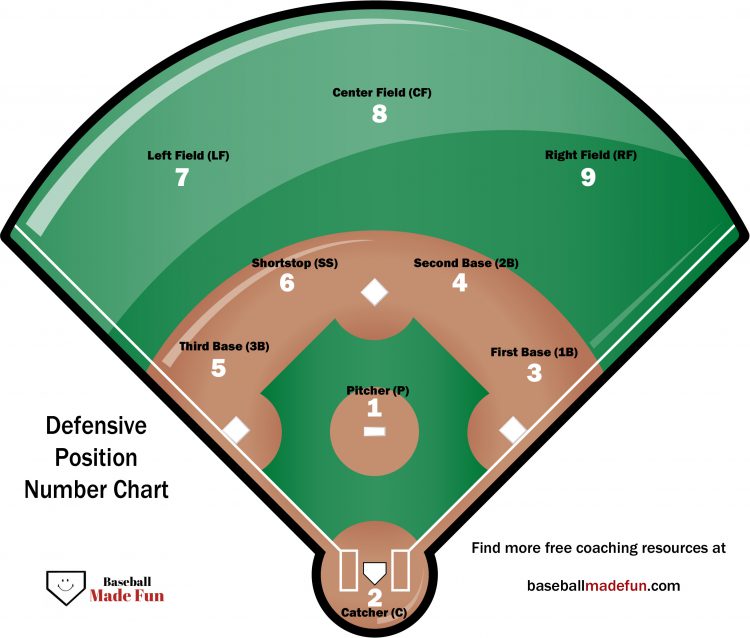Baseball position numbers are used primarily for scoring in a score book or for use on lineup cards. If you are relatively new to the game of baseball, you may be confused when you hear someone call the defensive positions by numbers.
For example, you’ll often hear a play-by-play announcer say, “It goes down as a 1, 3 put out,” (ball went to pitcher and he throws to the first baseman for an out). Or you’ll hear, “That’s a 6-4-3 double play,” (ball went shortstop, then to second baseman, then to first baseman and resulted in 2 outs).
Now you no longer have to be confused by the math on this popular t-shirt. Clearly, 6 + 4 + 3 CAN equal 2!
Here are the numbers that correspond to each defensive position on the field:
1 – Pitcher
2 – Catcher
3 – First Baseman
4 – Second Baseman
5 – Third Baseman
6 – Shortstop
7 – Left Fielder
8 – Center Fielder
9 – Right Fielder
Non-defensive designations you will see on baseball lineup cards or in the score book:
You will also see these letter abbreviations in score books and in lineups. However, the corresponding players will not be on the field playing defense, they will only be in the batting lineup.
DH: Designated Hitter (allowed in most youth leagues, high school, college, minor leagues and in the American League of Major League Baseball)
EH: Extra Hitter (only allowed in youth and little league baseball)
If you’d like to view or print out the baseball position numbers diagram at the top of this post, head on over to our baseball lineup templates page for the PDF version.



As a former coach of youth leagues, I find this to be valuable information. I remember the first time I was helping out my son’s coach. I had volunteered to help because his regular assistants couldn’t make that game. I thought he was going to ask me to coach either first or third base. Nope, he handed me the clipboard and asked me to keep score. I had no clue what those numbers meant. I quickly put together a cheat sheet after discussing my “problem” with the coach…lol. I went on to become a coach and it was all a funny memory from there. Your print out offering is a great idea for all the up and coming coaches!!!!
Thanks for the comment Dennis, and thank you for volunteering to help coach your son’s team! It’s volunteer coaches like yourself that will make the biggest impact on a kid’s love of the game. I’m glad to hear that you would have found this info valuable when you were first starting out…scoring can be quite tricky 🙂 I hope my message and resources will be useful to all the up and coming coaches out there!
Very interesting you decided to write an article helping people understand the baseball position numbers.
I was aware of this being a dedicated baseball player since very young, also did some coaching later in my years before giving baseball totally up due to health problems.
I am wondering how you ever thought about writing an article on this topic on baseball, it is very helpful and useful for many people to understand the numbers and positions?
Hi Jeffery. Thanks for the comment. When doing research, I found that “defensive position numbers” was a very common search term on the Internet. While they may be second nature to people who have been around the game for a while, new fans, players and coaches may find them to be a bit confusing. I’m hoping this article will help clear up any confusion.
Being a coach, I am surprised at the number of baseball players that are reaching the high school level that is confused or don’t understand the baseball positions by number. I remember my dad teaching me the importance of knowing how to keep score in a scorebook and that having a high baseball IQ will help the game become more natural to me.
Hi John, thanks for the comment. I agree. It’s surprising how little baseball knowledge some players at the high school level have, even after having played the game for many years. I think the focus on playing as many games as possible, with limited practice time may be partially to blame. Another factor may be that there are a lot of other distractions for kids to occupy their time with. Many kids don’t ever watch the game on TV or go to professional games. Much of what we learned as kids came from watching the game, not just playing it.
Thank you for being of assistance to me. I really loved this article.